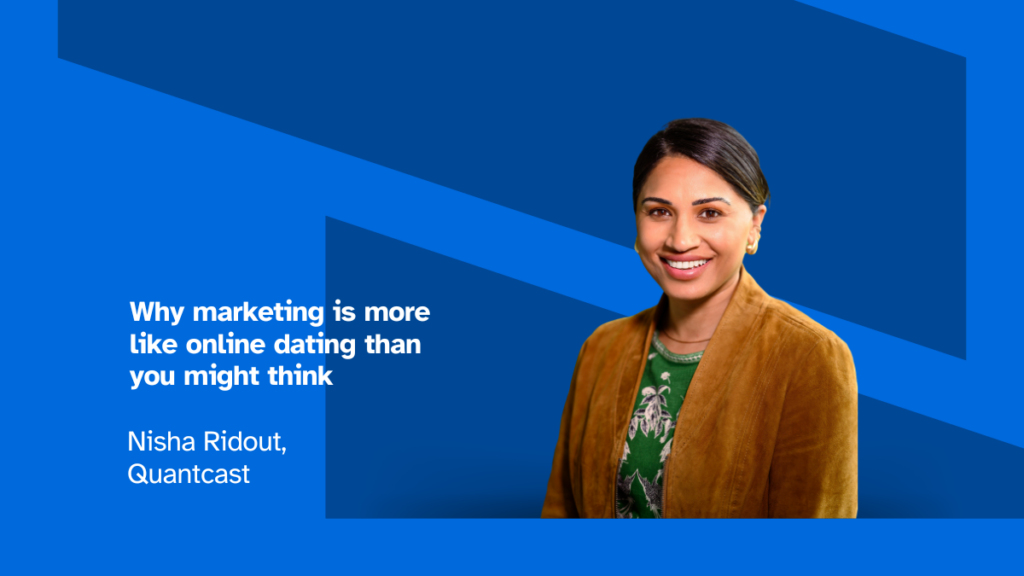By Nisha Ridout, Marketing Director at Quantcast
Kicking off my career with a five-year stint in the online dating industry has been both a great conversation starter and a valuable learning experience for my career in the adtech industry. Turns out, dating and advertising aren’t so different after all!
Think back to 1995, when Match.com made its debut. Founded by entrepreneur Gary Kremen as part of a plan for classified ad sites, it let singles “advertise” their interests and dream matches. It was basically a lonely hearts column, but online.
Fast forward to today, and apps like Bumble and Tinder have taken that concept, added a digital glow-up, and made it swipeable. If you take the time to think about it, the parallels with marketing are hard to miss – both are all about delivering the perfect message to the right audience at just the right moment. Whether it’s nurturing a love interest or building brand loyalty, the game is remarkably similar.
Not to sound superficial here, but people are visual creatures and simply can’t help but make judgements based on aesthetics. There’s science behind it and everything! Research has shown it can take as little as a tenth of a second to create a first impression. For both marketing and dating, the initial interaction can set the tone for future engagement. Just as in dating, where people form opinions within seconds, consumers quickly judge brands based on their first impression, whether it’s through an ad or a website visit.
So, how can you make sure you’re leaving a lasting impression? By understanding your audience. Not so long ago, the advertising industry used to be built on assumptions about target demographics. For instance, historically, make-up and skincare adverts predominately targeted women, while tools and gadgets were more aimed at men. Luckily, as third-party cookies continue to disappear, relying on outdated ‘insight’ to outline campaign strategies is becoming old news.
Today, more advertisers are building specific audience profiles including location, age range, hobbies and purchasing behaviour to create a hyper-personalised campaign. Only people who fit the profile will see the ad in question, which in turn should increase the likelihood of site visits and successful conversions.
These campaigns are also built on AI-driven insight, so if you’ve just spent money on a new gaming console, you’re more likely to receive targeted ads for games and accessories than another console. Nobody needs a PS5 following them around the internet, a week after buying one.
Using insights to then tailor messages to the individual is crucial in both marketing and online dating. In marketing, brands succeed by customising offers and experiences to a customer’s preferences. Similarly, in dating, taking the time to understand someone’s likes – such as planning a date around their favourite activities – helps build stronger, more meaningful connections. I’d like to think someone copying and pasting the same opening line into their matches’ DMs doesn’t have a very high success rate…
Marketers should be taking note of what the data tells them about the campaigns that are delivering the highest ROI and those that aren’t. Is there a common denominator in the content that’s resonating? If yes, double down on it and remove the creative that’s failing to meet expectations. Again, it’s like the online dating world, if your likes suddenly drop off after updating your profile photo, you’d probably reconsider that selfie you took in bad gym lighting, wouldn’t you? The same thing goes for campaigns.
Fortunately, measurement-focused adtech platforms offer this level of insight and can help marketers switch creative. Not quite as speedily as swiping right, but it’s not far off!
The sometimes-brutal world of online dating has more in common with marketing than you might have thought. For brands looking to get the highest return on their campaigns, particularly in the run-up to Christmas, they should consider lessons from the online dating world. Take the time to really consider target audiences, personalise your message and build in-depth profiles, then take advantage of real-time data and adjust your results if it’s not delivering. Otherwise, just be pleased the only time marketers have to worry about ghosting is when they start planning Halloween creative.







